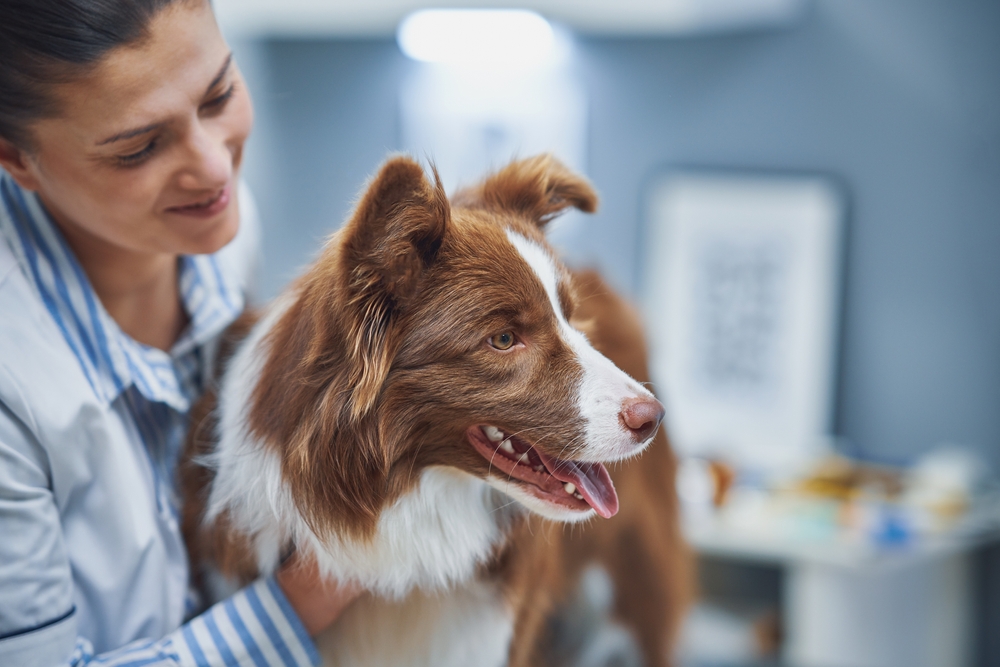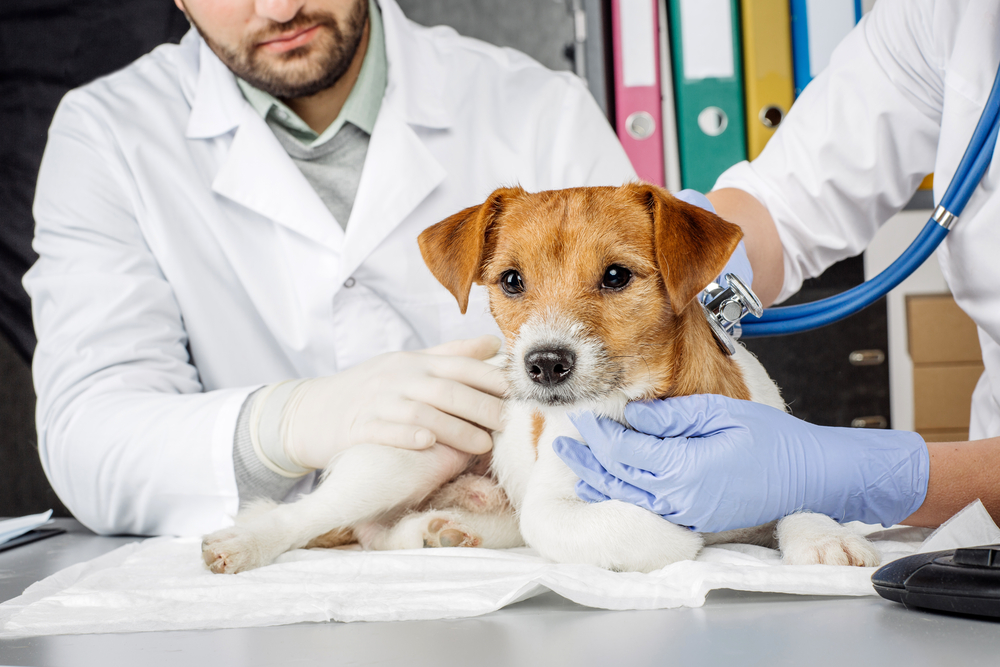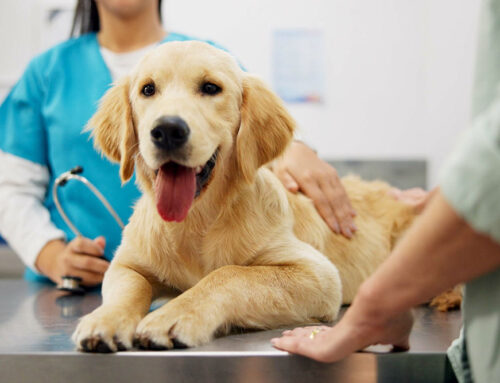Bloat in Dogs: What It Is, What to Watch For, and Why You Shouldn’t Wait
Let’s set the scene: it’s 10 p.m., your dog just inhaled dinner like it was a competitive sport, and now they’re pacing, drooling, and trying to throw up- with nothing coming out. Your gut says something’s wrong. You hop on Google, type in “dog bloated belly won’t vomit,” and are immediately met with a terrifying acronym: GDV.
Welcome to the blog that explains exactly what Gastric Dilatation-Volvulus (GDV) is, why it’s so dangerous, and what you need to know to act fast. At Animal Hospital Southwest, we see and treat true emergencies like GDV- and we’re here to walk you through it.
Wait- What Is GDV, and Is It Really That Bad?
Short answer: Yes. It’s that bad.
GDV, or gastric dilatation-volvulus, is a life-threatening condition where a dog’s stomach fills with gas, then twists on itself. This twist (the volvulus part) cuts off blood flow to the stomach and other vital organs, trapping gas and food inside. The blockage prevents normal digestion, causes severe swelling, and quickly impacts the heart, lungs, and other organs. If not treated immediately, it can cause tissue death, systemic shock, and even death- sometimes within hours.
This is not the same as mild bloating after a big meal. In GDV, the combination of trapped gas and a rotated stomach makes it physically impossible for the dog to burp or vomit, so pressure keeps building. Circulation is compromised, toxins build up, and the body begins to shut down.
According to the American College of Veterinary Surgeons (ACVS), GDV is one of the most urgent and critical emergencies in veterinary medicine. So yes- this blog is serious- but we’ll keep it clear, straightforward, and useful so you know exactly how to respond if you ever face it.
How to Spot GDV Before It’s Too Late
Here’s the tricky part: in its early stages, bloat can look deceptively mild. Dogs may just seem restless, uncomfortable, or “off.” Because these symptoms can mimic less serious issues, it’s easy to underestimate what’s happening. But the signs escalate fast, and once shock sets in, every minute counts.
Red Flags of Bloat and GDV:
- Swollen or tight abdomen (can feel hard to the touch)
- Unproductive retching or gagging (trying to vomit, but nothing comes out)
- Excessive drooling
- Pacing, whining, or signs of anxiety
- Rapid breathing or panting
- Collapse or difficulty standing
- Pale gums or cold extremities (a sign of shock)
If your dog is showing any of these symptoms, call us immediately at (817) 292-8655. We provide same-day urgent care and will guide you through what to do next. Learn more on our emergency care page.
Some cases progress from “acting odd” to “life-threatening” in under an hour, so never assume you have time to wait. Even a short delay can mean a more complicated surgery, longer recovery, or a less favorable outcome.
Why Does GDV Happen?
Great question- and unfortunately, science hasn’t given us a single, simple answer yet. What we do know is that GDV seems to be triggered by a combination of anatomy, genetics, and certain lifestyle factors.
Dogs at Higher Risk Include:
- Large and giant breeds (Great Danes, German Shepherds, Boxers, Standard Poodles)
- Deep-chested breeds (tall from spine to sternum but narrow from side to side)
- Dogs that eat too quickly
- Dogs fed one large meal a day
- Anxious or stressed dogs
- Dogs with close relatives who have had GDV
Some researchers also suspect that vigorous exercise immediately before or after eating may contribute, especially in deep-chested breeds. While no one can predict exactly which dogs will develop GDV, the risk factors are well documented.
According to the Pawlicy Dictionary’s overview of breed-specific risks, these dogs should be monitored extra carefully. If you’ve got a dog that checks several of those boxes, you’re not being paranoid- you’re being smart.
Emergency or “Wait and See”?
This is not one of those “give it a day and see if they perk up” situations. GDV is a true emergency. The longer you wait, the more damage is done internally, and the more complex- and costly- the treatment becomes.
Here’s a simple rule of thumb, backed by AAHA’s emergency checklist: If your dog is bloated and trying to vomit with no result- go. Now. Even if it turns out to be something else, it’s always better to be safe.
Not sure it qualifies? AVMA’s emergency resources can help you compare symptoms, but when in doubt, call. Our team can help you decide your next step and prepare the hospital for your arrival.
How GDV Is Treated
Once your dog arrives at the hospital, time is of the essence. Treatment for GDV typically involves:
- Immediate stabilization: IV fluids to support circulation, pain relief, and oxygen therapy if needed
- Decompression: Inserting a tube or needle to relieve pressure in the stomach
- Surgery: To untwist the stomach, assess tissue for damage, and remove any compromised sections if necessary
- Gastropexy: Surgically attaching the stomach to the abdominal wall to prevent future twisting
Surgery is almost always required for true GDV cases, and the sooner it’s performed, the better the outcome. Dogs that receive prompt, aggressive treatment often recover well and return to their normal routines within weeks.
Can GDV Be Prevented?
You can’t completely eliminate the risk, but you can reduce it- especially for dogs in the high-risk category.
One of the best prevention strategies is prophylactic gastropexy, a surgery that tacks the stomach in place before any twisting happens. While it doesn’t prevent simple “bloat” (gas buildup without twisting), it can prevent the life-threatening volvulus.
This guide to gastropexy explains how it works and what to expect. At Animal Hospital Southwest, we often recommend this procedure during spays or neuters for large breeds, or as a planned elective surgery for high-risk adults. It’s a proactive step that can save a life later.

We’re Here When It’s Urgent- and When You’re Not Sure
At Animal Hospital Southwest, we’re trained for emergencies like GDV, but we’re equally committed to the everyday health wins that keep your dog thriving. From annual exams and arthritis management to middle-of-the-night bloat scares, we have the tools, expertise, and compassion to respond quickly and effectively.
We also believe prevention is powerful. Talking through risk factors, diet, feeding schedules, and preventive surgery options before there’s an emergency can make all the difference. You’re not just a pet owner- you’re your dog’s advocate, and we’re here to be your veterinary co-pilot every step of the way.
Call Now If You’re Concerned. Schedule Today If You’re Curious.
Noticing symptoms of bloat? Don’t wait– call us right away at (817) 292-8655 or just come right in.
Want to discuss gastropexy, senior pain care, or that “he’s just not acting like himself” feeling?
Book an appointment online and let’s take care of it- before it becomes an emergency.







Leave A Comment